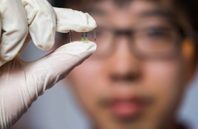In a pair of recent papers, two different research groups have brought the unique properties of ultrathin dielectric metasurfaces to bear on some problems in quantum information and communications.
In one demo, researchers in Australia, Taiwan and the United States teamed up to create a metasurface “camera lens” for use in imaging-based measurements of a photon’s quantum state. And, in the other, an Israel-based group developed a metasurface that’s capable of entangling the spin and orbital angular-momentum states of individual photons as laser light passes through the surface. The two research teams both see significant potential in the use of dielectric surfaces in addressing quantum-optical problems.
Dielectric metasurfaces are highly engineered, ultrathin surfaces decorated with arrays of subwavelength scattering elements. They’ve gained a lot of press in recent years for their ability to radically downsize bulk optical elements such as lenses. The researchers behind the first study, led by OSA Fellow Andrey Sukhorukov of the Australian National University (ANU), wanted to see if they could use the tiny metasurfaces to replace the bulk, tabletop-scale beam-splitting optical elements commonly used in experiments to realize quantum interference.

 (585) 768-2513
(585) 768-2513

